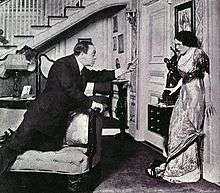Max Figman and Lolita Robertson
_-_11.jpg)
Max Figman (March 9, 1866- February 13, 1952) born in Vienna, Austria and Lolita Robertson (March 7, 1888- May 1, 1959) born in San Francisco, were a husband and wife acting duo who appeared on Broadway and in silent films together. Max was also a director and writer in his stage career. Max was 22 years Lolita's senior but the couple was long married and devoted to each other until Max's death in 1952. They had two children Max Jr. and Lolita Figman.[1][2] [3]

Max and Lolita appeared in a hit play Fine Feathers in 1913 co-starring Wilton Lackaye and Robert Edeson.[4]
The couple sat in on the formation of The Lasky Company in 1914, later to be Paramount Pictures.[5] In silent pictures the husband and wife often appeared together.
Max stage career
Max made his stage debut at 17 in A Scrap of Paper (1883). He later joined the company of Willie Edouin in Fun in a Photographic Gallery. He later appeared in four plays with Mrs. Fiske Miranda of the Balcony, A Doll's House, Hedda Gabler and Mary of Magdala. In 1905-06 he supported Florence Roberts in Ann La Mont and The Strength of the Weak. Break out as a star in the play version of The Man on the Box, filmed in 1914 by Cecil B. DeMille. From 1909-10 he toured in Mary Jane's Pa and in February 1912 was at Daly's Theatre New York in The Truth Wagon. Began his relationship with Lolita Robertson while in the play Fine Feathers first at the Cort Theatre Chicago Aug. 1912 and finally in New York at the Astor Theatre Jan. 1913.[6]
Filmography
|
Max Figman
|
Lolita Robertson
|
References
- ↑ Lolita Robertson bio ; IMDb.com
- ↑ Max Figman bio;IMDb.com
- ↑ The Spokesman-Review, February 26, 1913 - Lolita Robertson Finds time to Be a Star and an Old-Fashioned Mother by Margaret Hubbard Ayer
- ↑ Pictorial History of the American Theatre: 1860-1970 p.140 c.1970; originally 1958 by Daniel Blum, 1970 edition enlarged by John Willis
- ↑ Pictorial History of the Silent Screen p.54 c.1952 by Daniel Blum
- ↑ Who Was Who in the Theatre: 1912-1976 vol.2 D-H p.835, originally published annually by John Parker; 1976 edition by Gale Research Company
External links
| Wikimedia Commons has media related to Max Figman. |
| Wikimedia Commons has media related to Lolita Robertson. |
- Max Figman on IMDb
- Max Figman at the Internet Broadway Database
- Lolita Robertson on IMDb
- Lolita Robertson at the Internet Broadway Database
- Lolita portrait gallery (University of Washington, Sayre collection)
- Max Figman portrait gallery (University of Washington, Sayre collection)
- Lolita Robertson portrait (University of Louisville, Macauley Theatre collection)
- Max Figman when he was under the management of John Cort
- Max and Lolita in a scene from the film Whats His Name